Sign up for our newsletter, to get updates regarding the Call for Paper, Papers & Research.
Malay Traditional Jewellery: The Innovation of Pending as Contemporary Fashion Accessories in Malaysia
- Nazirah Mohamad Ba’ai
- Nur Siti Khadijah Zullkifle
- Mohd Fairus Yussof
- Noorhaslinda Mohamad Ali
- Asliza Aris
- Hema Zulaika Hashim
- 1170-1177
- May 17, 2023
- Cultural Studies
Malay Traditional Jewellery: The Innovation of Pending as Contemporary Fashion Accessories in Malaysia
Nazirah Mohamad Ba’ai 1*, Nur Siti Khadijah Zullkifle 2, Mohd Fairus Yussof 3, Noorhaslinda Mohamad Ali 4, Asliza Aris 5 and Hema Zulaika Hashim 6
1,2,3,4,6 Department of Contemporary Metal Design, Collage Creative of Arts, University Teknologi MARA (UiTM) Malaysia
5Department of Fashion Design, Collage Creative of Arts, University Teknologi MARA (UiTM) Malaysia
DOI: https://doi.org/10.47772/IJRISS.2023.7497
Received: 05 April 2023; Accepted: 19 April 2023; Published: 17 May 2023
ABSTRACT
Pending is part of traditional jewellery, often used to complement Malay clothing. Aristocratic people usually wear this pending on the waist on special occasions and gatherings, such as weddings and cultural events. Since Pending is no longer as popular as it once was, this study suggests improving and innovating existing functions. New mechanisms have shown viable replacements for traditional features. This study aims to resurrect the Pending into a modern multi-function buckle as a contemporary fashion accessory in Malaysia. Qualitative research involving observation and description analysis is applied using a formal analysis approach. This research helps to preserve Malaysia’s culture and become a reference point for academics, designers, goldsmiths, historians, and other related professions in art, culture, and heritage of traditional jewellery.
Keywords— Malay Traditional Jewellery, Pending, Innovation, Contemporary, Fashion Accessories.
INTRODUCTION
Malaysia has a rich cultural heritage, and one of the most beautiful aspects of its culture is its traditional jewellery. Among the various types of traditional jewellery in Malaysia, pending stands out as a unique and innovative accessory that has gained popularity as a fashion statement. Pending is a type of jewellery that replaces the head of the belt worn with traditional clothing by Malay men and women (Zubaidah Sual, 2022). Interestingly various collections pending from the National Museum, Kuala Lumpur, were discovered.
This accessory has a fascinating history and has evolved into an innovative and stylish addition. In this journal article, we will explore the evolution of pending as a fashion accessory in Malaysia, exploring its history and significance in the Malay community. With intricate designs and rich history, pending has become a symbol of tradition and elegance in Malaysia. This article aims to comprehensively understand the innovation of pending as a fashion accessory in Malaysia and its significance in Malaysia’s cultural heritage.
Malaysia is rich in customs and traditions such as wedding ceremonies, which have dokoh, head ornament (cucuk sanggul), bracelets, leg ornaments, and waist ornaments (Pending) are often used by men and women as a complement to clothing. According to Esa S.R., Aziz A.A., Mahamood M. (2018), many generations today are unaware of the functions and applications of this traditional Malay jewellery. Aside from that, the younger generation prefers minimalist and trendy belt buckles. Ismail Ali (2019) also mentions people increasingly prefer to wear caps rather than Tanjak or headgear and choose to wear belts with a variety of buckles rather than the Pending. Thus, the researchers took the opportunity to study maintaining the characteristics of traditional jewellery (Pending) as a heritage to adapt into the fashion accessories design with modern concepts and create awareness about traditional jewellery from being forgotten.
Therefore, examining the selected illustrations shows the pending design production process in a modern context with various functions. These details will be elaborated further in the findings and aligned with previous research to establish a clear analytical framework and approach.
LITERATURE REVIEW
Traditional jewellery is closely related to fashion accessory design, which requires knowledge of past, present, and future fashion trends. According to DeMello (2007), humans wear jewellery to enhance their appearance and pending is classified as a type of body jewellery. In ancient times, pending was used daily as a clothing complement, with pending serving as a belt or fastener to tighten the kain sarung or sampin (Siti Zainon, 2009; Zubaidah Sual, 2022).
In the Malay community, pending is not only a part of being a clothing accessory. Pending was made for protection against evil spirits and stabbing. (Putri Eliza, 2021). Moreover, Zawawi et al. (2019) state that a gold belt buckle is considered a status symbol among Southeast Asians. It is one of the tools of royal majesty, making it a highly valued cultural ornament among the Malay community (Zubaidah Sual, 2022).
According to Hayati Mohamad Zawawi, Sabzali Musa Kahn, Raja Suriaty Raja Ahmed (2019), Kassim (1988,1997), Yusof (1984) and Siti Raudhah (2016), in socio-cultural pending also serves as a status symbol and a symbol of the Malay community, especially the sultan and the royal family. Effendy (2005) and Putri Eliza (2021) explained that the symbolic meaning of wearing pending as an amulet is to protect the body and spirit. According to Azah Aziz (2006) and Siti Zainon Ismail (2009), this jewellery is traditionally worn on the waist (refer to Fig. 1). The belly button is believed to be the weakest part of the body. It can be targeted for stabbing or subjected to magical influences such as the tuju type. Additionally, it is believed to be a place where subtle beings may enter.
Fig. 1 Way of use pending.
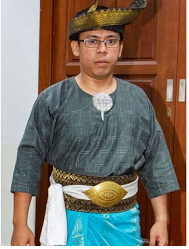
Source: https://www.beritaharian.sg/setempat/anak-muda-giat-hidupkan-minat-terhadap-busana-melayu
The Innovation of Jewellery Design
This research approach provides valuable insights and opportunities for conversation about the future of jewellery design. The selected cases show that it is possible to produce things with new meanings by moving technologies away from their usual and expected roles (Thayane T., 2020). These innovative meanings may allow the discussion of societies’ contemporary issues. For instance, these cases indicate how design can benefit from technology to adopt a speculative position (Dunne and Raby, 2013) and thus encourage society to discuss ideas that shape the world.
A technological and humanised culture in jewellery design emerges from this. The selected case also reveals the shift towards the multi-function of traditional jewellery (Thayane T., 2020). For example, Malay traditional pendants are ornaments worn at certain times, such as public gatherings, weddings, and an instrument of majesty in the Malay Monarch. This initiative will familiarise the younger generation with pending jewellery and its uses. In the 20th century, fashion accessories played a significant role in enhancing a person’s appearance. These accessories come in different sizes, shapes, colours, etc. According to Nicole Phelps (2019), fashion accessories are divided into jewellery, shoes, handbags, gloves, and belts.
The Characteristics of Pending
Pending is a jewellery form worn on a waist made from precious materials such as gold, silver, copper, and rose gold. The original pending is from fabric bends or folds in the shape of a belt. In ancient times, pending was used as a belt head or bengkung in the categories of body jewellery (Kassim Mohd Ali, 2008).
The shape is a central element in a jewellery design. In the old days, Malay artisans made natural resources such as leaves and the shape of the eye as inspiration to produce designs Pending as symbolic of the shield tummies. The form of Pending comes in a variety, such as organic and geometric. In Malay word, it is called Bujur lancip. The other shapes are oval, round, and rectangular (Fig. 2).
Fig. 2 Pending in various shapes.
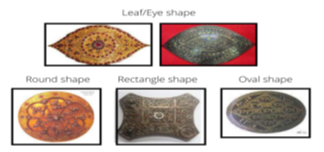
Sources: Collection from Textile Museum Kuala Lumpur.
Malay traditional jewellery (Pending) has five essential parts: the inner frame, the outer frame, the head of the pending, the body part, and the centre point (Fig. 3). Traditional Malay artisans are highly artistic and skilled, persevering with strength and inspiration to turn traditional design elements into distinctive and aesthetically beautiful creations.
Fig. 3 Design features essential to the Pending‘s overall structure, developed by Nazirah Mohamad Ba’ai (2023)
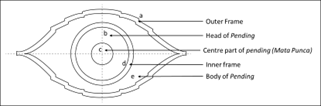
Sources: National Museum Textile, Kuala Lumpur
The characteristics of pending include its multifunctional diversity and intricate designs. Pending is created by combining aesthetics and functionality, and it can be adjusted or varied to fit human demands and desires due to the attire and styling. Its designs are often intricate and feature traditional Malay motifs, such as the bunga melur and bunga tanjung (Zubaidah Sual, 2022). Thus, this clearly shows that pending is a unique and significant traditional Malay jewellery with various functions and characteristics in the Malay context. Its multifunctional diversity and intricate designs make it a valuable cultural ornament among the Malay community.
METHODOLOGY
The methodology of this research is qualitative method. An object-based research method is applied to observe, describe, and analyse the pending using a model of artefact study by Fleming, E.M. 1974 (Fig. 4). This paper discusses the formal analysis method for defining and rating traditional Malay jewellery’s visual and material appearance of pending. Most of the data was acquired through observation and visits to the National Museum of Kuala Lumpur, the older generation who has experienced jewellery artefacts, and the specialists in the area, such as costume traditional and contemporary costumes collectors and entrepreneurs.
Fig. 4 Model of artefact study by Fleming, E.M. 1974
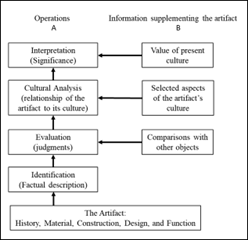
Data Collection
The illustrated data of 23 designs of the pending products was gathered from the National Museum in Kuala Lumpur. The design motif of the product was from varied types of pending and belt chains (refer to Table 3.1). This method seeks to analyse visual form using visual data.
Table I. The types of pending forms and shapes, by Nazirah Mohamad Ba’ai (2023)
| Type of Pending | Form Shape | Descriptions |
| Bujur lancip |  |
This shape resembles the human eyeball, referred to as a suspended gem because of its tapered oval shape, meaning it is pointed or tapered at both ends. |
| Bujur berhujung pepat |  |
This shape has a flat and equal corner or tip without any sharp or tapered effect on the end. |
| Cycle |  |
A cycle shape is a circular or oval shape often used to represent or evoke a sense of continuity, repetition, or movement. Additionally, cycle shapes can emphasise or draw attention to a particular element within a design or create a focal point. |
| Oval |  |
|
| Long rectangle |  |
The long rectangle shape creates a sense of proportion, balance, and harmony in the overall design. |
The researcher determined through observation and document analysis that the pending collection is comprised of two primary forms such as geometric and organic. The three identified geometric shapes are round, long rectangles, and pointed ovals (Siti Zainon, 2009; Siti Raudhah et al., 2016). At the same time, the pending organic design can be identified through the pointed oval shape at the end. In the context of design elements, the pending geometric shape’s size is smaller than the pending organic shape, where the length is more extensive, it is because this is intended as an attraction to the wearer. In addition, this type of pending also has a complete pattern design and a more loaded variety of decorations, motifs, and gemstones.
The Jewellery Design Process
Design is one of the essential components of manufacturing jewellery. Developing innovative design processes, techniques, strategies, and procedures in jewellery design is significantly more critical for meeting the end user’s needs. In this phase, designers and jewellers should focus on customer needs and current trends (Hashim HZ, 2020).
This phase of the process is related to determining the suitability of the design idea to produce a jewellery design. The jewellery design process involves several stages, from ideation to the final production of a piece of jewellery (refer to Fig. 5). According to Elizabeth Galton (2012), the design process of jewellery includes five main stages: ideation, sketching, rendering, 3D modelling, and prototyping. The following are some further explanations of the design process.
- The first stage of the jewellery design process is ideation, where designers generate ideas and conceptualise their designs by brainstorming and researching for inspiration.
- The second stage is sketching, where designers create rough sketches of their thoughts on paper or using a digital platform.
- The third stage is rendering, which involves creating a detailed visual representation of the design. Designers use software like Adobe Illustrator to create digital renderings of their designs, including colour, texture, and other details.
- The fourth stage is 3D modelling, where designers create a virtual model of the jewellery using specialised software. This stage allows designers to see the design from different angles and make any necessary adjustments before the final production.
- The final stage is prototyping, where a physical design model is created. This stage allows designers to test the design and make necessary changes before the final product once the design is finalised and sent to the production team for manufacturing.
The new design needs to go through the fabrication process, and selecting suitable materials, such as precious metals, is an essential matter at this stage (Ba’ai, N. M., Hashim, H. Z., Aris, A., & Anwar, R. (2015). In this scenario, the design requires several levels of specific modifications, such as the size of the appropriate design shape and composition of the motif and gemstone placement (see sets 1 and 2 in Fig. 6).
Generally, the jewellery design process involves several stages, from ideation to final production, and requires creativity and technical skills. It is a complex process that requires attention to detail and an understanding of the materials and manufacturing techniques used in jewellery production.
Fig. 5 The process of form finding.
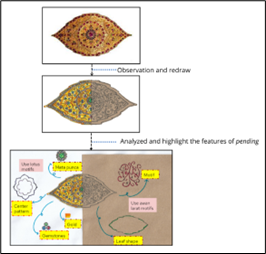
Source: Nur Siti Khadijah Zullkifle (2021)
Fig. 6 Design process: Composition of the motif and gemstone placement
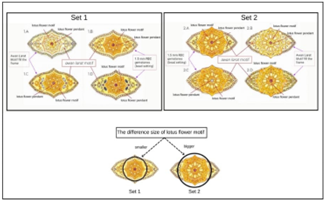
Source: Nur Siti Khadijah Zullkifle (2021)
FINDING
This study elucidates the function of Pending as a piece of traditional Malay jewellery and how its design can be improved through the creative and exploratory ideation process. The study has demonstrated how designers can work within the constraints of the original form, additional elements, and cultural significance to produce innovative and meaningful jewellery designs. The research has also highlighted how traditional Malay jewellery can be reintroduced and adapted to meet contemporary trends and needs by incorporating modern manufacturing techniques.
One of the main findings of the research is the multifunctional nature of Pending jewellery, as demonstrated by the example of the hair comb and magnetic pendant in Figure 6. This design incorporates traditional motifs and elements and provides practical functions for the wearer. The use of magnets as a primary technique in the pendant design is a creative solution that enhances the usability and versatility of the jewellery piece.
This research has contributed to developing new concepts, methods, and innovative ideas in Malay traditional jewellery design. By understanding traditional designs’ constraints and cultural significance, designers can create unique and meaningful jewellery pieces that reflect modern consumers’ evolving needs and tastes while preserving the heritage and tradition of Malay jewellery.
Fig. 7 Pending as Fashion Accessories (A: Hair Comb, B: Magnetic Pendant)

Source: Nur Siti Khadijah Zullkifle (2021)
CONCLUSIONS
In conclusion, this study highlights the significance of Pending, a traditional Malay jewellery piece commonly used to complement Malay clothing during special events and gatherings. While it is no longer as famous as it once was, this study proposes enhancing and innovating its existing functions to resurrect it into a modern multifunctional buckle as a fashion accessory in Malaysia. The study employs qualitative research methods, such as observation and descriptive analysis, utilising a formal analysis approach. By preserving Malaysia’s cultural heritage, this research can serve as a valuable reference point for academics, designers, goldsmiths, historians, and other related professionals in the field of art, culture, and traditional jewellery. Overall, this study provides an opportunity to revive and modernise traditional Malay jewellery, allowing it to continue to be appreciated and utilised by future generations.
ACKNOWLEDGEMENT
The team would like to thank the following individuals for the fruitful discussion and the anonymous audience from the previous Innovation, Ideation and Design (IIDEX 2021 and MTE2022) for valuable comments and ideas on the exhibition; it contributed to the refinement of the contextualisation approach for the study. This support is appreciatively acknowledged by the College of Creative Arts (formerly known as the Faculty of Art and Design) for its continuous funding to preserve and appreciate the nation’s culture in developing the jewellery field in Malaysia.
REFERENCES
- Azah Aziz, 2006. Rupa & Gaya Busan Melayu, Bangi, Universiti Kebangsaan Malaysia.
- Ba’ai, N. M., Hashim, H. Z., Aris, A., & Anwar, R. (2015). The Innovation of Biomaterial in Jeweler Design. In Proceedings of the International Symposium on Research of Arts, Design and Humanities (ISRADH 2014) (pp. 499-506). Springer, Singapore. DOI: 10.1007/978-981-287-530-3_51
- DeMello, M. (2007). Body adornment: A comparison of the attitudes of women and men. Clothing and Textiles Research Journal, 25(3), 245-256. https://doi.org/10.1177/0887302X07302845
- Elizabeth Galton, (2012). Basics Fashion Design 10: Jewellery Design: From Fashion to Fine Jewellery, AVA Publishing SA.
- Esa S.R., Aziz A.A., Mahamood M. (2018) Pending: A Study on Form, Design, and Content of Malay Ornament. In: Anwar R., Mahamood M., Md. Zain D., Abd Aziz M., Hassan O., Abidin S. (eds) Proceedings of the Art and Design International Conference (AnDIC 2016). Springer, Singapore.
- Fleming, E. M. (1974). Artefact study: A proposed model. Winterthur Portfolio, 9, 153-173. Sources: https://www.jstor.org/stable/1180572 (25 August 2020).
- Hashim, HZ and RAHMAN, KHAIRUL AIDIL AZLIN and Khairi, Hanif, Jewelry Design Process Directs on the Idea of Purchasing a Jewelry Piece (November 5, 2020). Proceedings of the 4th International Symposium of Arts, Crafts & Design in South East Asia (ARCADESA), Available at SSRN: https://ssrn.com/abstract=3807697 or http://dx.doi.org/10.2139/ssrn.3807697
- Hayati Mohamad Zawawi, Sabzali Musa Kahn & Raja Suriaty Raja Ahmed “ Koleksi Pending Emas: Tipologi Dan Teknik Pertukangan Logam” JMS Vol. 2 Issue 1 (2019): 328 – 351
- Ismail Ali (2019). Anak Muda Giat Hidupkan Minat Terhadap Busana Melayu. Berita Harian, Retrieved: 3 Mac 2023. Sources: https://www.beritaharian.sg/setempat/anak-muda-giat-hidupkan-minat-terhadap-busana-melayu
- Kassim, M.A. (2008). Traditional Malaysian Jewellery, Utusan Publications & Distributors Sdn. Bhd, Kuala Lumpur.
- Mohamad Ba’ai, Nazirah and Khairi, Hanif and Ahmad, Hasma (2015) Apresiasi barang kemas tradisional Melayu: satu kajian mengenai budaya bahan / Nazirah Mohamad Ba’ai…[et al.]. In: ICOMHAC2015 eproceedings, 16-17 Disember 2015, Century Helang Hotel, Pulau Langkawi. https://ir.uitm.edu.my/id/eprint/35784
- M. Zawawi, H. M., Kahn, S. M., & Ahmed, R. S. R (2019). Perhiasan Pending: Analisis Perbandingan Reka Bentuk Pending Melayu Dan Baba Nyonya. Akademi Pengajian Melayu,Universiti Malaya.
- Nicole Phelps (2019), Oscar De la Renta 2020, Retrieved: 3 Mac 2023. Sources: https://www.vogue.com/fashion-shows/spring-2020-ready-to-wear/oscar-de-la-renta
- Siti Raudhah Esa, Arba’iyah Ab Aziz, & Muliyadi Mahamood. (2018). Pending: A Study on Form, Design and Content of Malay Ornament. Proceedings of the Art and Design International Conference (AnDIC 2016), 109-116. https://doi.org/10.1007/978-981-13-0487-3_13
- Siti Zainon Ismail. (2009). Pakaian Cara Melayu. Bangi: Penerbit Universiti Kebangsaan Malaysia.
- Tavares, T. (2020). New Technologies Shift in Jewelry Design: From Traditional Optimization to Contemporary Speculation. Global Fashion Conference.
- Tenas Effendy (2005). Ungkapan Tradisional Melayu Riau Edisi Kedua. Dewan Bahasa dan Pustaka, Malaysia

